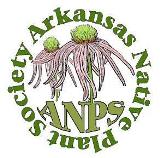Canada rockcress (Borodinia canadensis*) of the Mustard (Brassicaceae/Cruciferae) family has small white flowers and long pendent bean-like fruits. The genus name most likely commemorates the Russian botanist Ivan Parfenievich Borodin (1847-1930) who founded the Russian Botanical Society. The specific epithet denotes the species’ occurrence in eastern Canada. In the U.S., it is found primarily from eastern Oklahoma and southern Minnesota, east to Massachusetts and the southern Appalachians. In Arkansas, Canada rockcress occurs primarily throughout the Interior Highlands. Habitat preference is dry to well drained, sandy to rocky soils of open areas. Other common names include sicklepod and sicklepod rockcress.
This biennial, developing from seed in late fall, forms an elongate taproot and a basal rosette of simple leaves over winter. The earliest basal leaves tend to be spatulate and petiolate while later basal leaves are mostly obovate and sessile. As the central stem develops, basal leaves may expand to 4 inches long and 1¼ inches wide. Early leaves are green to purplish above and dark purple beneath. Pinnate venation, though obscure, is somewhat enhanced by purplish coloration. Leaf margins have 6 to 8 prominent undulating pairs of teeth angled toward the apex as well as basal ear-like lobes on the lowermost blades. Basal leaves are covered with dense, white, straight or curved hairs.


A straight, erect, green to bluish central stem develops in spring as basal leaves drop away, growing to a height of 3 feet, including the terminal raceme. Robust stems may have a few lateral flower-bearing branches above. Stems have scattered straight or curved pubescence, more so near the base. Pubescence is lost as plants mature.
The alternate, simple, ascending to arching stem leaves are lanceolate to oblanceolate, sessile or short-petiolate near the base. Lower stem leaves are 4 inches long and 1 inch wide, the size decreasing upwards. Leaf pubescence is variable: lower leaves and lower leaf surfaces are hairier while more distal leaves and upper leaf surfaces may be glabrous. Venation of stem leaves is similar to that of basal leaves.


By mid-April, the growing stems are topped with a tight cluster of football-shaped flower buds covered with dense minute pubescence. As stems continue to elongate, the structure of the inflorescence becomes apparent: a bractless raceme, a hallmark of the mustard family. Primary racemes may bear 60+ flowers and grow to more than a foot long in fruit. On more robust plants, they may be branched. Flowers of a raceme bloom sequentially from base to apex. Pubescence is lost as fruiting progresses.

Flowers develop on down-curved, half-inch-long, minutely pubescent pedicels. Perianth parts are in fours: 4 sepals, 4 quarter-inch-long petals. The androecium comprises 6 stamens, 4 long and 2 short, another hallmark of the family. There is a single pistil. The narrow tips of the linear white petals (about 3/16 inch long) extend just beyond the sepals and become widely spread to expose the anthers. The elongate, 2-carpellate pistil, with its minute style, remains mostly hidden.

Fertilized flowers, the sepals shed, produce long, slender, glabrous, 2-valved, bean-like fruits (siliques) that become prominently curved with maturity. Mature siliques, to 4 inches long and ⅛ inch wide, are of uniform width and thickness. They become tangled with one another as they elongate. When fruits are mature, the valves break apart and seeds are shed. Dead plants with their prominent seedless fruits become a light tan in color.
Structure of the ovary and fruit of the mustard family is unique. The partition separating the valves is not a seed-bearing placenta––seeds are attached not to the partition itself (this would be axile placentation) but to the junction of the partition with the valve, creating parietal placentation. (The partition is often termed a false septum or replum.) There are thus 4 lines of ovules in the ovary and 4 lines of seeds in the mature siliques. This becomes evident when the siliques dehisce along the junction of the valves: valves fall away while the replum, with seeds still attached on both sides of its edges, remains on the receptacle. The flattened round to oval seeds separate one from another with each seed retaining a “halo” of the translucent replum. Seeds are dispersed by wind.


With its height and distinctive racemes, Canada rockcress adds textural variety to a garden (see Photo 6). Nectar and pollen are beneficial to small flies and bees. At the end of the growing season, plants quickly disintegrate. It is apparently not an aggressive self-seeder.
Three other species of the genus Borodinia occur in Arkansas: smooth rockcress (Borodinia laevigata), Missouri rockcress (Borodinia missouriensis), and Short’s rockcress (Borodinia dentata). Canada rockcress can be distinguished by its 1) pubescent basal leaves with prominent teeth (but not significantly lobed), 2) non-clasping, tapered to the base, mostly sessile stem leaves, and 3) down-curved pedicels bearing pendent flowers and wider long curved fruits.
*Formerly classified as Boechera canadensis and Arabis canadensis. More recently, based on DNA testing, Canada rockcress and other Boechera species in Arkansas have been transferred to form a clade with Borodinia macrophylla, an Asian species.
Article and photographs by ANPS member Sid Vogelpohl

